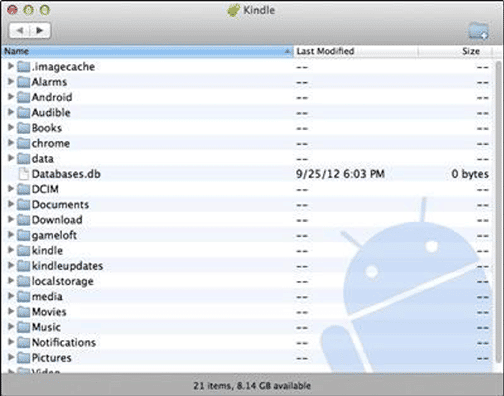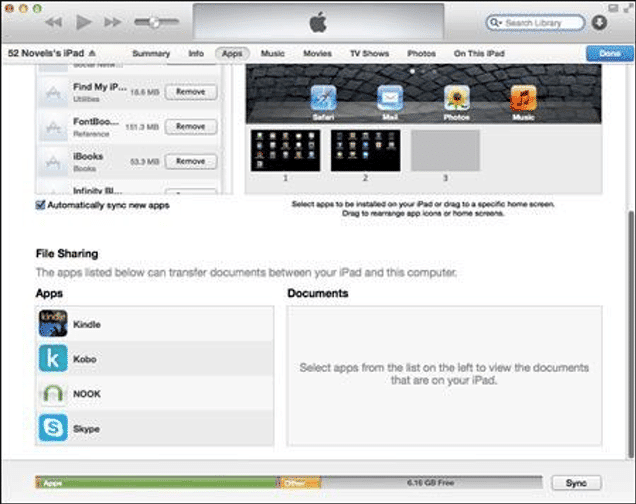Use the step-by-step instructions below to sideload your e-book files to e-reader devices and apps.
MOBI Files
Using the “Send to Kindle” App
- From a PC: Send to Kindle for PC
- From a Mac: Send to Kindle for Mac
- By email: Send to Kindle by Email
Sideload to a Kindle from a Windows Computer
E-ink Kindle
- Save the mobi file to a convenient location on your computer, such as the desktop.
- Attach your device to your computer using a micro-USB cable. One should’ve been included with your Kindle.
- Wait for your computer to recognize the device and display the AutoPlay window.
- Click Open folder to view files to open Windows Explorer.
- When Windows Explorer opens, double-click documents and move the window aside.
- Find the mobi file you saved in step 1, then drag-and-drop it into the device’s documents folder you opened in Step 5.
- Wait for the file to transfer and safely eject the device from your computer.
- The e-book should appear on the device’s home screen.
Kindle Fire
- Save themobi file to a convenient location on your computer, such as the desktop.
- Attach your device to your computer using a micro-USB cable. One should’ve been included with your Kindle Fire.
- Wait for your computer to recognize the device, then click the Start Globe and select Computer to open Windows Explorer.
- Note: In some cases, it may be necessary to unlock the Kindle Fire before your computer recognizes the device.
- Under Portable Devices, double-click Kindle > Internal Storage.
- Double-click Books and move the window aside.
- Find the mobi file you saved in step 1, then drag-and-drop it into the device’s Books folder you opened in Step 5.
- Wait for the file to transfer and safely eject the device from your computer.
- The e-book should appear on the device’s carousel screen. If not, tap Docs on the top menu, then tap Device: the e-book should appear there, as well.
Sideload to a Kindle from a Mac
E-ink Kindles and Kindle Fire 1st Generation
- Save the mobi file to a convenient location on your computer, such as the desktop.
- Attach your device to your computer using a micro-USB cable. One should’ve been included with your Kindle.
- Your Mac mounts the device as a drive. Find the following icon on the desktop and double-click it:

- Find the mobi file you saved in step 1, then drag-and-drop it into the device’s documents.
- Wait for the file to transfer and safely eject the device from your computer.
- The e-book should appear on the e-ink device’s home screen, or the Android device’s carousel screen.
Kindle Fire 2nd Generation and Kindle Fire HD
Mac users with a Kindle Fire 2nd Generation or Kindle Fire HD will first need to install the free Android File Transfer app to complete USB transfers. Go to File Transfer App using your computer’s Web browser and follow the onscreen instructions to download and install the app.
- Save the mobi file to a convenient location on your computer, such as the desktop.
- Attach your device to your computer using a micro-USB cable. One should’ve been included with your Kindle Fire.
- Use Finder to navigate to the Applications folder and double-click the File Transfer App. Your Mac opens the device’s file system, as shown below:

- Find the mobi file you saved in step 1, then drag-and-drop it into the device’s Books.
- Wait for the file to transfer and safely eject the device from your computer.
- The e-book should appear on the device’s carousel screen. If not, tap Docs on the top menu, then tap Device: the e-book should appear there, as well.
Sideload to a Kindle App
Kindle for PC or Mac
- Save the mobi file to a convenient location on your computer, such as the desktop.
- Download an install the Kindle app for your computer’s operating system.
- Find the mobi file you saved in step 1 then double-click it. It should open with the Kindle app.
- Note: In some cases, it may be necessary to right-click the file and select the application.
Kindle for Android
- Save the mobi file to a convenient location on your computer, such as the desktop.
- On your device, tap the Google Play Store or Amazon App Store icon then find the Kindle for Android app and install it.
- Attach your phone or tablet to your computer using the USB cable that came with the device.
- Wait for your computer to recognize the device, then click the Start Globe and select Computer to open Windows Explorer.
- Under Portable Devices, find and double-click Kindle and move the window aside.
- Find the mobi file you saved in step 1, then drag-and-drop it into the device’s Kindle folder you opened in Step 5.
- Wait for the file to transfer and safely eject the device from your computer.
- Open the Kindle app. The e-book should appear on the device’s Home screen.
Kindle for iPad/iPhone/iPod—Method 1
The Kindle for iPad/iPhone/iPod app does not yet fully support Kindle Format 8, Amazon’s next-generation e-book file format. Accordingly, some design features may not display exactly as they do on other Kindle devices and apps. Please keep this in mind when reviewing mobi files on an Apple iOS device with the Kindle app installed.
- Save the mobi file to a convenient location on your computer, such as the desktop.
- On your device, tap the App Store icon then find the Kindle for iPad/iPhone/iPod app and install it.
- Attach your iPad, iPhone or iPod to your computer using the USB cable that came with the device.
- Open iTunes if it does not open automatically.
- On the top menu, click Apps and then scroll to the bottom of the window to see the File Sharing section, as shown below in iTunes 11.0.1.12:

- In the Apps panel on the left-hand side, click the Kindle
- Find the mobi file you saved in step 1 and drag-and-drop it into the Documents panel on the right-hand side.
- Wait for the file to transfer and safely eject the device from your computer.
- Open the Kindle app and the mobi file should appear on the app’s Device Library screen.
Kindle for iPad/iPhone/iPod—Method 2
- Send an email to yourself with the mobi attached.
- When you open Mail on the iPad you’ll see your attachment.
- Click on it and you’ll get a dialog asking if you want to open it in Kindle or another app.
- Select Kindle and the program will run with that book opened.
ePub Files
Sideload to a Nook from a Windows Computer
E-ink and Tablet-based Nooks
- Save the ePub file to a convenient location on your computer, such as the desktop.
- Attach your device to your computer using a micro-USB cable. One should’ve been included with your Nook.
- Wait for your computer to recognize the device and display the AutoPlay window, as shown below. (Some Nooks may require you to swipe the Launcher to unlock the device before your computer will recognize it.)

- Click Open folder to view files to open Windows Explorer.
- When Windows Explorer opens, double-click My Files > Books and move the window aside.
- Find the ePub file you saved in step 1, then drag-and-drop it into the device’s Books folder you opened in Step 5.
- Wait for the file to transfer and safely eject the device from your computer. You may have to click the Sync button in the lower right-hand corner of the application window to complete the transfer process.
- The e-book should appear on the device’s Library. Consult the device’s documentation for more information on accessing the Library.
Sideload to a Nook from a Mac
E-ink and Tablet-based Nooks
- Save the ePub file to a convenient location on your computer, such as the desktop.
- Attach your device to your computer using a micro-USB cable. One should’ve been included with your Nook.
- Your Mac mounts the device as a drive. (Some Nooks may require you to swipe the Launcher to unlock the device before your computer will recognize it.) Find the following icon on the desktop and double-click it:

- When the Nook drive window opens, double-click My Files > Books and move the window aside.
- Find the ePub file you saved in step 1, then drag-and-drop it into the device’s Books folder you opened in Step 3.
- Wait for the file to transfer and safely eject the device from your computer.
- The e-book should appear on the device’s Library. Consult the device’s documentation for more information on accessing the Library.
Sideload to an iPad or iPhone—Method 1
- Save the ePub file to a convenient location on your computer, such as the desktop.
- Launch iTunes and select Add to Library… from the File menu.
- Select the ePub you saved in step 1 and click the Choose
- From iTunes, select Books from the list of libraries on the left. The book should now be listed in your iTunes library.
- Connect your iPad or iPhone to the computer using the USB cable that came with the device and select it from the list of devices on the left.
- Choose Books
- Check the Sync Books checkbox if it isn’t already enabled. You can sync all books in your library with your iPad or iPhone, or choose the select books you want to sync.
- Now click the Apply or Sync button at the bottom right of the window (you may receive a warning that this will erase all the books on your iPad if this is your first iBooks sync).
- Once the sync has completed, you can open iBooks on your iPad or iPhone to read your newly transferred title.
Sideload to an iPad or iPhone—Method 2
- Send an email to yourself with the epub attached.
- When you open Mail on the iPad you’ll see your attachment.
- Click on it and you’ll get a dialog asking if you want to open it in iBooks or another app.
- Select iBooks and the program will run with that book opened.
